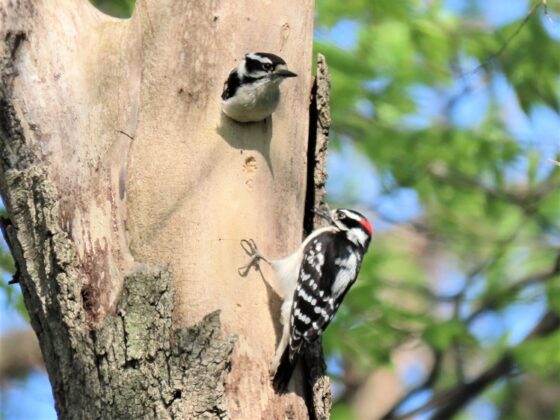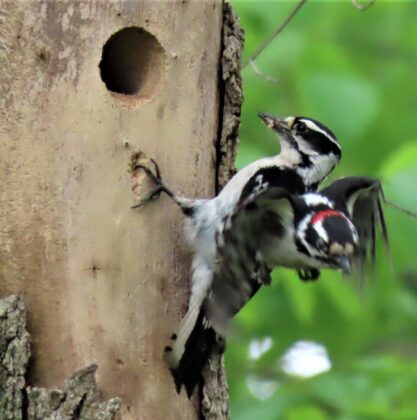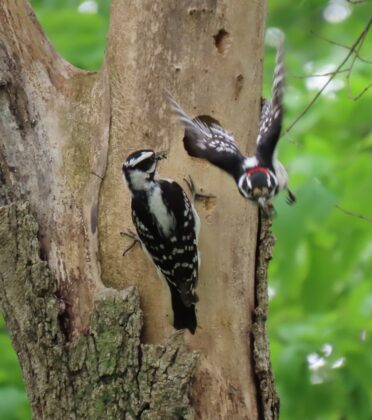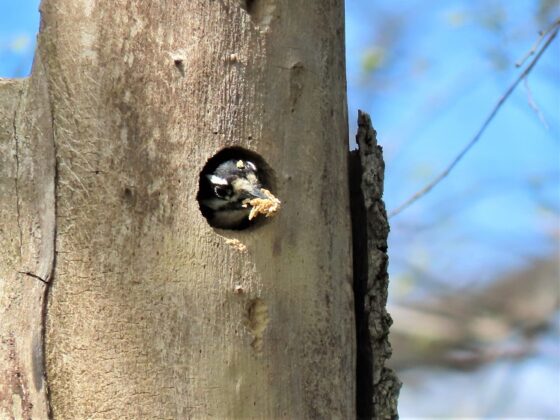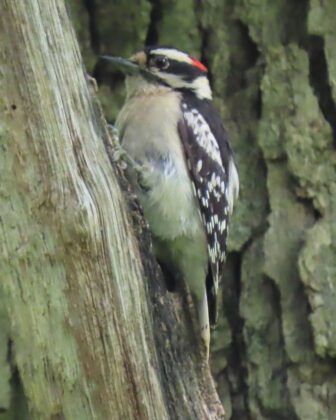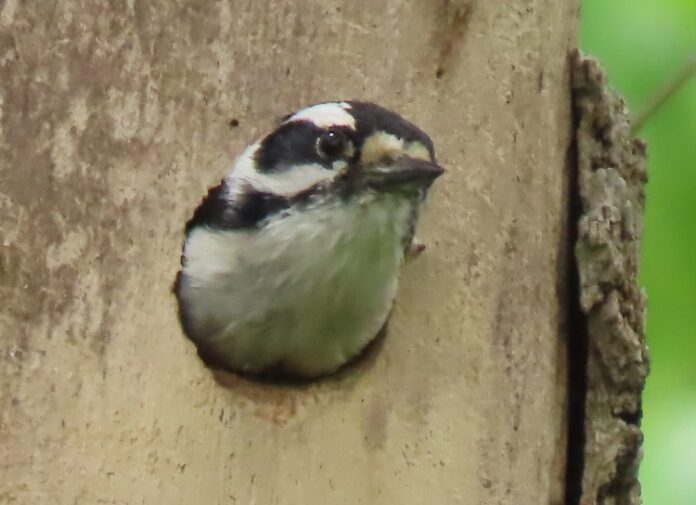
On a pleasant day in mid-February 2020, a male downy woodpecker was drumming on a snag of a elm tree in the northwest corner of my property. He froze when he saw me. He probably hoped that the human would move on. But when I didn’t move, he slowly moved around to the other side of the tree, putting the dead tree between us.
I finally walked on, and after a minute he continue his drumming.
Several days later, I returned to the area, and he was pecking away on the same tree. He seemed to have purpose to his hammering. He was not just making sound. Now he was drilling a hole into the tree.
The dead elm was a little more than foot in diameter, and it was just a bare stem not more than 20 feet tall. He was hammering near the top, where most of the bark had peeled off, and he has chosen a spot just below a joint where a limb had broken off.
Later a female downy joined him and was pecking at the hole, too. She was chiseling away with the same determination as the male. Obviously, they had decided to make their nest in the dead elm tree.
It is easy to identify the sex of the adult downy woodpeckers. The male has a small red cap on the back of his head, but the female’s head is just black and white. They are called “downy” because of the patch of peach-fuzzy-like feathers at the base of their bills.
I decided to set up my bird blind near the tree so I could watch and photograph the events of their nest making.
Soon the birds were able to get half of their bodies into the opening. The industrious pair kept excavating the opening and by April 26, they could go into the hole, where they were completely hidden from view.
They would take turns going into the tree and bring a beak full of wood chips to the opening and drop them. Soon there was a small pile of sawdust material at the base of the tree.
One day when the male was inside the nest hole, throwing out woodchips, a house wren stopped to investigate. It was probably looking for a nest site, too. The little downy exploded out of the tree and chased the wren. Both of them were squawking as they flew around the trees and bushes. When the wren was gone, the male returned to the tree and continued his task.
On a very windy day, I was sitting in the blind, observing their behavior. The female was inside the tree cavity and occasionally dumping out large mouthfuls of woodchips. Soon the male arrived and landed next to opening and peered inside.
The female came out and flew to a nearby branch. The male flew and landed next to her and jumped on her back. By the time I got my camera out and focused, she had flown away, and the male went inside the tree and began removing more woodchips.
I expected to see babies in a few weeks.
The wood chiseling activity stopped about the first of May, and the incubation process began. The birds would take turns sitting on the nest inside the tree. They seemed to have the timing to about one-half-hour each inside the tree, then relieved by the mate. When it came near time for the exchange of places, the bird would look out of the hole as if it wondered why its mate was late.
It seemed that the male spent more time on the nest than the female. On one occasion, he went into the tree and stayed inside. When the female returned, he stuck out his head and looked at her, then went back inside. I don’t know what he communicated to her, but the female flew away.
On May 19 the pair were coming to the tree with food in their mouths. The eggs had hatched, and the feeding had begun. About every 10 to 15 minutes, the birds would arrive with a mouth full of insects or caterpillars.
I would look at all the nearby trees and shrubs, trying to locate them before they arrived at the nest, but I seldom saw them until they were at the opening. They flew in from a different direction each time. Ornithologists report that birds do this behavior to keep predators from following them to the nest.
The birds flew in predictable directions when they left the tree. The female usually flew south, while the male usually flew east down the fencerow. They probably had their preferred hunting areas. Also, when they left the nest, they would frequently have a fecal sac in their beak.
At the end of May, there were some peeping sounds coming from inside the tree, but no baby woodpeckers were seen. At this time, when the birds returned with food, they didn’t enter the tree. They stayed outside and put their heads in the hole to feed the young.
A week later, on June 8, I saw a baby bird moving inside the tree. It seemed strange that the parents were staying away longer periods of time between feedings.
Sadly, I missed observing the woodpeckers for the next three days. Upon returning, there was no feeding activity. The female was never seen again at the nest, and the male came once, and he did not go inside the tree.
When a wren went inside the hole, I knew that the young had fledged. What a disappointment. I had hoped to get some photos of the babies coming out of the old elm tree.
Downy woodpeckers have been coming to my feeders all winter, eating sunflower seeds and suet. Maybe this coming spring I can witness their nest building activities again.
Ray Harden is a member of the Perry Tree Board.






